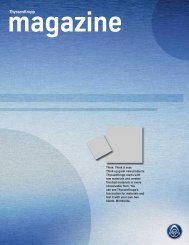Annual Report 2003 2004
Annual Report 2003 2004
Annual Report 2003 2004
Create successful ePaper yourself
Turn your PDF publications into a flip-book with our unique Google optimized e-Paper software.
Long-lived asset impairment (including definite-lived<br />
intangible assets)<br />
The carrying values of long-lived assets such as property, plant and<br />
equipment, and purchased intangibles subject to amortization are<br />
reviewed for possible impairment whenever events or changes in<br />
circumstance indicate that the carrying amount of an asset may not<br />
be recoverable. In the event that facts and circumstances indicate<br />
that the carrying amount of any long-lived asset may be impaired,<br />
an evaluation of recoverability would be performed whereby the<br />
estimated future undiscounted cash flows associated with the asset<br />
would be compared to the asset’s carrying amount to determine if a<br />
write-down to fair value is required. The remaining useful life of the<br />
asset is evaluated accordingly. An impairment loss is recognized to<br />
the extent that the carrying amount exceeds the asset’s fair value.<br />
Inventories other than percentage-of-completion<br />
contracts<br />
In the 4th quarter of fiscal year <strong>2003</strong>/<strong>2004</strong>, the Group changed its<br />
method of valuing similar inventories from the last-in, first-out method<br />
(lifo) to the average cost method. This change has the greatest<br />
impact on the Steel segment and less impact on the other segments.<br />
The change to the new valuation method is preferable as it provides<br />
comparability with major competitors in the Steel industry as well as<br />
creates consistency of the valuation method used for similar inventories<br />
within the Group. In accordance with apb 20 “Accounting Changes”,<br />
the change from the lifo method has been applied retrospectively<br />
by adjusting all prior periods presented in the income statement (see<br />
Note 4).<br />
Inventories are stated at the lower of acquisition/manufacturing<br />
cost or market. The elements of costs include direct material, labor<br />
and allocable material and manufacturing overhead.<br />
Receivables<br />
Receivables are stated at net realizable value. If receivables are<br />
uncollectible or deemed uncollectible, bad debt expense and a<br />
corresponding allowance for doubtful accounts is recorded.<br />
Receivables that do not bear interest or bear below market interest<br />
rates and have an expected term of more than one year are<br />
discounted with the discount subsequently amortized to interest<br />
income over the term of the receivable.<br />
The Group sells undivided interests in certain trade accounts<br />
and notes receivable both on an ongoing and one-time basis to<br />
135<br />
Financial <strong>Report</strong><br />
Consolidated financial statements<br />
qualifying special purpose entities or other lending institutions.<br />
Financial assets sold under these arrangements are excluded from<br />
accounts receivable in the Group’s balance sheet at the time of sale.<br />
Cash and cash equivalents<br />
Cash and cash equivalents comprise cash on hand, checks, deposits<br />
with national banks, as well as other bank deposits with an original<br />
maturity of three months or less.<br />
Marketable securities<br />
All marketable securities in which the Group invests are classified<br />
as available-for-sale and valued at market prices as of the balance<br />
sheet date. Any unrealized gains and losses, net of deferred income<br />
taxes, are reported as a component of the “Accumulated other<br />
comprehensive income” line item within equity. An other than<br />
temporary loss of value in an available-for-sale security is realized<br />
in the statement of income and a new cost basis for the security is<br />
established.<br />
Deferred income taxes<br />
Income taxes are accounted for under the asset and liability method.<br />
Deferred tax assets and liabilities reflect both net loss carry forwards<br />
and the net tax effects of temporary differences between the carrying<br />
amounts of assets and liabilities for financial reporting purposes and<br />
the amounts used for income tax purposes. Deferred taxes are<br />
measured using the currently enacted tax rates in effect during the<br />
years in which the temporary differences are expected to reverse.<br />
The effect on deferred tax assets and liabilities of a change in tax<br />
law is recognized in the period that the law is enacted. Deferred tax<br />
assets, net of valuation allowances, are recognized only to the extent<br />
that it is more likely than not that the related tax benefits will be<br />
realized.<br />
Accumulated other comprehensive income<br />
Accumulated other comprehensive income includes changes in the<br />
equity of the Group that were not recognized in the income statement<br />
of the period, except those resulting from investments by owners and<br />
distributions to owners. Accumulated other comprehensive income<br />
includes foreign currency translation adjustments, unrealized holding<br />
gains and losses on available-for-sale securities and on derivative<br />
financial instruments, as well as additional pension liabilities not yet<br />
recognized as net periodic pension cost.

















